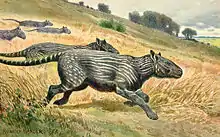Phenacodontidae
Phenacodontidae is an extinct family of large herbivorous mammals traditionally placed in the “wastebasket taxon” Condylarthra, which may instead represent early-stage perissodactyls.[2][3] They lived between the Paleocene and Eocene epochs (about 60–50 million years ago) and their fossil remains have been found in North America and Europe, and it is closely related to the horse.
| Phenacodontidae | |
|---|---|
 | |
| Phenacodus | |
| Scientific classification | |
| Kingdom: | Animalia |
| Phylum: | Chordata |
| Class: | Mammalia |
| Order: | Perissodactyla (?) |
| Family: | †Phenacodontidae Cope 1881[1] |
| Subfamilies & genera | |
| |
Description
These animals had a variety of body sizes, and could be as small as domestic cats (Tetraclaenodon and Ectocion) and as large as sheep (Phenacodus). The skull of phenacodontids is long and narrow, and equipped with a small braincase.
The skeleton of phenacodontids show several primitive characteristics (the long and heavy tail for example) but also a number of advanced, Perissodactyla-like adaptations: Their long legs, for example, had five fingers, but the first finger showed a clear reduction, and in some forms (like Phenacodus) the fifth finger was reduced as well.
Some species had tapir-like adaptations suggestive of the presence of a short proboscis or a strong prehensile lip.[4]
The teeth of phenacodontids, particularly in the latter forms, were quite specialized: The molars and premolars were equipped with low cusps that sometimes joined in ridges, similar to the condition found in some perissodactyls. Some forms, like Meniscotherium, had enlarged ridges. This adaptation is unusual for mammals as old as phenacodontids.
Evolution
The phenacodontids evolved in the middle Paleocene in North America. Early forms were usually small; Tetraclaenodon, for example, was the size of a fox. Later forms were much larger and invaded Europe, although they never became as plentiful as in North America.
Towards the beginning of the Eocene these animals slowly disappeared from the fossil record. Only a few forms survived into the middle Eocene: the Phenacodus in Europe and North America, Almogaver in Europe and Ectocion in North America.
An exception to the scarcity of Eocene phenacodontids is the dog-sized genus Meniscotherium, whose fossils are very abundant.
Classification
The phenacodontids were classically included in the large, now thought to be artificial, order of Condylarthra. This order has been considered to be a wastebasket taxon for some time.
According to more recent views, instead of a monophyletic clade, the Condylarths are better understood as an evolutionary grade that lead to the true ungulates.[5] Indeed, recent phylogenetic studies confirm that phenacodonts were most closely related to modern odd-toed ungulates.[3][6]
Paleobiology
The specialized teeth found in at least some phenacodontids seem to indicate a primary herbivorous lifestyle. The shape of the legs indicated that some phenacodontids (like Phenacodus) were swift runners.
See also
- Radinskya, a basal perissodactyl from the Paleocene of China
Notes
- Cope, E. D. (1881). "A new type of Perissodactyla". American Naturalist. 15: 1017–1020. doi:10.1086/272983. OCLC 45953517.
- Phenacodontidae in the Paleobiology Database. Retrieved April 2013.
- Cooper, L. N.; Seiffert, E. R.; Clementz, M.; Madar, S. I.; Bajpai, S.; Hussain, S. T.; Thewissen, J. G. M. (8 October 2014). "Anthracobunids from the Middle Eocene of India and Pakistan are stem Perissodactyls". PLOS ONE. 9 (10): e109232. Bibcode:2014PLoSO...9j9232C. doi:10.1371/journal.pone.0109232. PMC 4189980. PMID 25295875.CS1 maint: ref=harv (link)
- Thewissen (1990). "Evolution of Paleocene and Eocene Phenacodontidae (Mammalia, Condylarthra)" (PDF). Papers on Paleontology. 29. University of Michigan: 1–120. Retrieved 20 October 2014. Cite journal requires
|journal=(help) - Naish, Darren (8 August 2013). "Phenacodontidae: I feel like I know you". Tetrapod Zoology. Scientific American. Archived from the original on 10 March 2014.
- Halliday, Thomas J. D.; Upchurch, Paul; Goswami, Anjali (February 2017). "Resolving the relationships of Paleocene placental mammals: Paleocene mammal phylogeny". Biological Reviews. 92 (1): 521–550. doi:10.1111/brv.12242. PMC 6849585. PMID 28075073.
References
- Agusti, Jordi; Anton, Mauricio (2002). Mammoths, Sabertooths, and Hominids: 65 Million Years of Mammalian Evolution in Europe. Columbia University Press. ISBN 0-231-11640-3.CS1 maint: ref=harv (link)
- Archibald, J. D. (1998). "Archaic ungulates ("Condylarthra")". In Janis, C. M.; Scott, K. M.; Jacobs, L. L. (eds.). Evolution of Tertiary Mammals of North America. 1: Terrestrial Carnivores, Ungulates, and Ungulate-like Mammals. Cambridge University Press. pp. 292–331.
- Prothero, D. R.; Manning, E. M.; Fischer, M. (1988). "The phylogeny of the ungulates". In Benton, M. J. (ed.). The Phylogeny and Classification of the Tetrapods. 2: Mammals. Oxford, UK: Clarendon Press. pp. 201–234.
- Tabuce, R.; Coiffait, B.; Coiffait, P.E.; Mahboubi, M.; Jaeger, J.J. (2001). "A new genus of Macroscelidea (Mammalia) from the Eocene of Algeria: a possible origin for elephant-shrews". Journal of Vertebrate Paleontology. 21 (3): 535–546. doi:10.1671/0272-4634(2001)021[0535:angomm]2.0.co;2.
- Tabuce, R.; Marivaux, L.; Adaci, M.; Bensalah, M.; Hartenberger, J.L.; Mahboubi, M.; Mebrouk, F.; Tafforeau, P.; Jaeger, J.J. (2007). "Early Tertiary mammals from North Africa reinforce the molecular Afrotheria clade". Proceedings of the Royal Society B. 274 (1614): 1159–1166. doi:10.1098/rspb.2006.0229. PMC 2189562. PMID 17329227.
- Thewissen, J. G. M. (1990). "Evolution of Paleocene and Eocene Phenacodontidae (Mammalia, Condylarthra)". Papers on Paleontology. 29. University of Michigan: 1–107. Cite journal requires
|journal=(help)